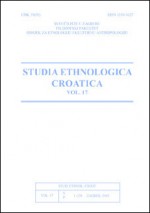Vještičje psihonavigacije i astralna metla u svjetovima hrvatskih predaja kao (mogući) aspekti šamanske tehnike ekstaze (i transa)
Witches’ Zoopsychonavigations and the Astral Broom in the Worlds of Croatian Legends as (Possible) Aspects of Shamanic Techniques of Ecstasy (and Trance)
Author(s): Suzana MarjanićSubject(s): Customs / Folklore, Cultural Anthropology / Ethnology
Published by: Sveučilište u Zagrebu, Filozofski fakultet
Keywords: witches; shamanism; zoopsyhonavigations; Croatian (mythic) legends;
Summary/Abstract: Taking as a starting-point, for example, the book Mythic Images and Shamanism: A Perspective on Kalevala Poetry in which Anna-Leena Siikala (2002:43), among other, emphasizes that “shamanism is not a religion, but rather a complex of rites and beliefs existing within different religions”, I shall consider witches’ zoopsychonavigations in the worlds of Croatian legends as (possible) aspects of shamanic techniques of ecstasy (and trance). On the one hand, I take the term zoopsyhonavigation to mean riding (flying) on the backs of animals (theriomorphic vehicles) by which witches hover in the air (the binomial anatomy/iconography of the Woman-Animal) and, of course, of incubus-like riding on men (shared by fairies and witches), as well as the witches’ psycho-navigational, astral broom that can be seen as an isomorphism of a phallomorphic applicator for a hallucinogenic ointment with an atropine-containing plant, and as an isomorphism of the horse-headed stick which is used by the Buryat shamans in their ecstatic dances. In any case, the Buryat shaman’s horse-headed stick is called the horse (and is not unlike the handle of the witch’s broom), figuring as some sort of hobby-horse, upon which the shaman rides, journeying to the other world (or, in Eliade definition, the symbolic “ride” expressed leaving the body, the shaman’s “mystical death”). On the other hand, in the framework of the term zoopsyhonavigation, I regard zoometempsychoses (the soul animal) as a temporary death, due to the fact that metempsychosis demands a transgression through death. For example, zoometempsychosis into a fly, which is attributed in legends to mora, witches and krsniks, strategies by the authoritative power (in Sloterdijk’s definition) of ecclesiastic authorities and folk ethics, is diabolised when mora and witches are in question, and is regarded from the aspect of its supernatural features when zoometempsychosis applies to krsniks. A similar ethical differentiation was also realized in the process of folk imagination of the zoometamorphoses (shape-shiftings) of witches, which were diabolised, while the zoometamorphoses of krsniks, achieved in psycho-navigational struggles for a fertile year (such facilitators include “other analogous beings ranging from Slovenia to Montenegro”, for example, obilnjaks, brgants, kombals, vedomacs, moguts, veds, vrimenjaks/ vremenjaks, višćaks, legromants/nagromants, vjedogonjas/jedogonjas, stuhas, zduhačs [cf. Bošković-Stulli 2005:134]), are understood as protective zoopsychonavigations. In addition to the above concept of zoopsychonavigation, I establish equally possible contacts between witchcraft and shamanism on the basis of the mythem about the mutual agon between shamans as well as between witches, the distinctive features of their birth (for example, their birth in a caul), the axis mundi topos – the mythic geography of mountains and trees (the parallelism between the shamanistic tree and the fairies’ tree), the use of hallucinogenic plants that have been noted in the practices mentioned, as well as the light-enhanced hypostases of the witches’ bodies in the context of Eliade’s attribution of the shaman as “a master over fire”.
Journal: Studia ethnologica Croatica
- Issue Year: 2005
- Issue No: 17
- Page Range: 111-169
- Page Count: 59
- Language: Croatian

